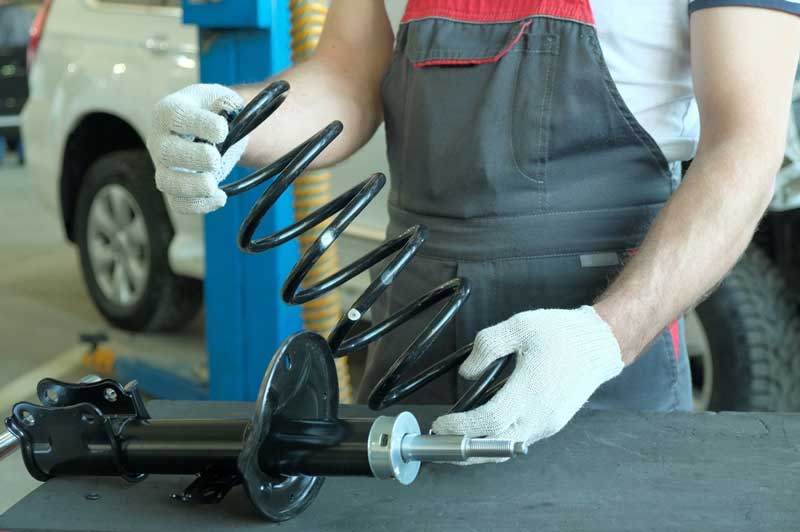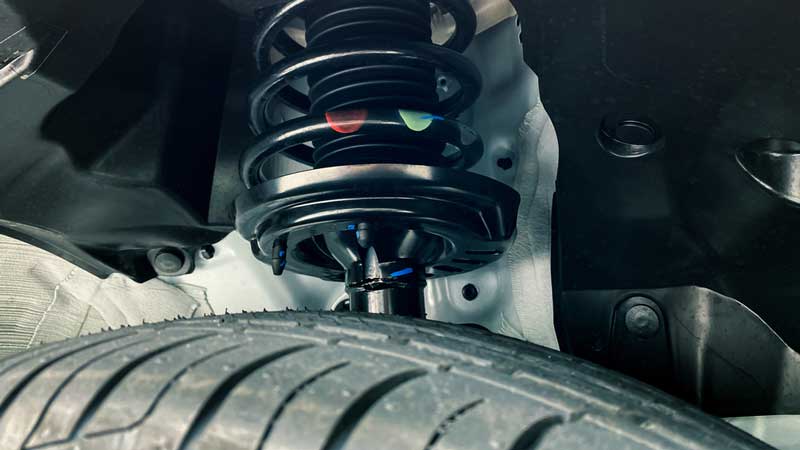Are you confused about the functions of shocks and struts? Do you intend to know the differences between shocks and struts? Do you think they both possess a similar function?
If these questions are going through your mind, this post is just for you.
Actually, both of these components aim to improve the ride & handling of your car, but they do so in different ways. You’ll be grateful if your vehicle’s shocks and struts function correctly when you drive over a pothole, speed bump, or other uneven roads.
Although these two parts of the car are frequently discussed together, they’re separate parts that each play a crucial role in keeping the car solid and secure.
This article will provide some clarification if you’ve ever been unclear about the distinction between shocks & struts. The functions of a shock and strut, as well as what happens when they are damaged.
Are you set? Let’s kick it off !!!
Differences Between Shocks And Struts
Shocks & struts are two separate components with different purposes. Both of these components aim to improve the ride & handling of your car, but they do so in different ways. While struts are a significant structural element of the chassis & suspension system, shocks are discrete parts of the suspension system.
Are Shocks and Struts the Same Part?
The suspension system of every car on the road today is made up of several different pieces, including springs and struts(shock absorbers). When a car collides with things on the road, springs are intended to sustain the vehicle & soften the impact.
The springs’ vertical movement or motion is limited by the shock absorbers, often referred to as struts, which also soak up or absorb the impact of road obstacles.
Also Read: Low Engine Oil Pressure (Causes & Solutions)
Given that they both perform the same purpose, people frequently confuse the terms struts & shocks to refer to the same component. The shocks & the strut, however, have different designs, & each has its pros and drawbacks:
- The individual suspension system’s design is the main distinction between a shock and a strut.
- Cars without an upper control arm use struts, which link to the knuckle; those with a solid axle(on the back) or a lower and upper control arm (independent suspension) utilize shock absorbers.
- On each of the four corners of every vehicle, a strut or shock will be used. Many employ struts up front and a shock absorber in the back.
What are Shocks?
The spring that dampens the jerks in an automobile is called a shock absorber, also referred to as the car’s suspension. It only delays the force’s arrival at the car, minimizing shock. Therefore, it is called a shock absorber.
A mechanical device that diffuses kinetic energy and dampens or smooths out any quick shock impulse; it typically consists of a spring plus dashpot combination.
Miniature-sized oil-filled coil-over shock components for automobiles. Shock “dampers”/shock absorbers are hydraulic or mechanical devices that reduce and absorb shock impulses, by transforming the shock’s kinetic energy into another type of energy—typically heat—which is subsequently diffused.
Dashpot shock absorbers are by far the most common, described together with hydraulic and pneumatic shock absorbers, cushions & springs.
Orifices and check valves with spring-loaded check valves regulate the oil flow through an interior piston of an automotive shock absorber. In contrast to air cylinders, which usually release hot air into the atmosphere, hydraulic cylinders allow the hydraulic fluid to heat up.
Other types of shock dampers, such as electromagnetic ones, can later be made with the stored dissipated energy. Generally speaking, shock absorbers assist in preventing vehicle damage from uneven surfaces.

What are Struts?
Struts make up the car’s suspension. They serve as shock dampers, reducing the impact of potholes & other imperfections on the road.
The wheel/axle bearing, brake assembly, & eventually the tire & wheel are held in place by the “knuckle” at the bottom of the strut. At the top, from behind the wheel or tire, the strut is connected to the car’s body or frame.
The top attachment and strut tower points on either side of the motor compartment are visible when you raise the hood on a vehicle with struts when you are about two-thirds of the way back from the front of the hood.
To correct for irregularities on the road surface, struts are suspension parts that combines shock absorbers & springs.
The units are tall & frequently mounted higher on the body to give them more room to move and accommodate significant bumps. The tips of the struts must also be connected to the suspension’s base. The control arms that support the ball joints and the spindles that support the wheel bearing assemblies or hubs are where they pivot relative to the frame.
Possible external fluid leakage from the struts is a red flag for a damaged strut. Your tires might cup. The strut enables lateral & longitudinal movement of the wheel.
An upper spring leg, a spring, a Shock absorber, and a lower wishbone (control arm) attachment point that joins the damper to the chassis or frame make up the Mac Pherson strut mechanism.
Main Differences Between Struts And Shocks
- The terms “dampers” and “shock absorbers” are synonymous. oscillations that occur when a vehicle’s suspension system is “damp out.” They typically work with leaf or coil springs; however, unlike struts, they don’t use the damper or coil as the pivot point for the vehicle’s steering.
- A strut’s whole assembly includes the spring, which is not the case for a shock’s assembly.
- A car can still be found resting on its springs even after the shocks have been removed, but the vehicle can’t rest on its springs if the struts are removed.
- Back shocks are used in large trucks. Whereas struts are used in the rear and front of passenger cars.
- Struts can be shocks, although shocks are not always struts.

Do All Cars Have Struts?
Shocks and struts are frequently paired in many automobiles. But struts aren’t an accessory found on every car. Your car could replace the struts with independent springs & shocks, depending on how it was built. There are several methods you can use to determine if your car has struts or shocks.
The Warning Signs Of Worn Shocks And Struts
Although various factors, including potholes, affect the lifespan of your struts or shocks, Reina advises that if you notice either of these seven indications, it’s time for repairs.
- At motorway speeds, there is instability. On the highway, you never feel like your car is entirely stable; it is always swaying up & down. Even though the movement is minute, you can feel itit
- The vehicle tends to “tilt” to one side. Your car tilts to one side when you make a sharp turn or exit a highway.
- Under strong braking, the front end dips deeper than anticipated. If you apply the brakes quickly, you might not notice this.
- As you accelerate, the back squats. When you drive faster you’ll notice that your car’s front end rises and its back “squats.”
- Excessive tire bouncing. You may experience some tire reaction or “bouncing” after striking a bump. You might also hear a clunking sound.
- Abnormal tire wears. The tread wears unevenly instead of in a wavy pattern due to the tire not being firmly attached to the road.
- External struts or shocks that are dripping fluid. The interior fluids necessary for proper operation are leaking as a result of damaged seals.
Also Read: Fuel Pump Fuse Location (How to Locate the Fuel Pump Fuse)
Frequently Asked Questions – Differences Between Shocks And Struts
Are shock & strut interchangeable terms?
The main distinction is that a shock is a standalone component, but a strut combines a shock with additional properties to form a single structural unit. Both assist in maintaining the stability of the car and the contact of the tires with the ground. Your car would jolt along the road without shock absorbers.
Can You Have a Shock and A Strut on the Same Vehicle?
Yes, a strut & a shock can both be used on the same car, which furthers the misunderstanding over shocks vs. struts. With shocks on the rear axle and struts on the front axle, you may find them on a lot of automobiles and trucks.
Struts or shocks: which is better?
Being components that support weight, struts are made to be significantly stronger compared to shocks. They also enhance your car’s steering & alignment while helping to cushion jolts in the vehicle.
Do I need to replace both my struts & shocks at the same time?
For predictable handling and control, struts and shocks should always be changed in pairs, or better yet, all four at the same time. All four of them have, after all, worked in the same conditions and have logged the same number of kilometers on the car.
Are shocks & struts both necessary?
Before anything else, it’s important to remember that not all cars have shocks & struts. Some vehicles just have struts, while others only have shocks. A strut is a whole suspension assembly, while shocks are a component of the total suspension. Your car’s struts and/or shock absorbers serve two purposes.
Do the back or front struts?
Struts are normally fitted in connection with the front wheels, although they can as well be put at the back wheels, depending on the configuration and driveline of a vehicle. There are different strut types, just like there are different automobile types.
What are the struts’ prices?
A set of struts should be replaced for approximately $450 to $900 on average. You should budget between $300 and $600 for parts alone because a single strut assembly will cost you between $150 and $300. The cost of the pair’s labor alone will be between $150 and $300.
Conclusion – Differences Between Shocks And Struts
Struts & shocks are frequently used interchangeably. Usually, this is a pleasant acquaintance for a person who may not be quite knowledgeable about suspensions but is still attempting to be of assistance.
The terms are commonly used interchangeably, leaving customers confused about what they need. Some automobiles have shock absorbers on the back and struts on the front wheel, which complicates matters even more.
Anything that can generally absorb vibration is considered a damper. One type of damper is a friction damper, usually called a shock absorber. A strut combines spring and a shock (damper) into one piece. In other words, a strut has a damper incorporated into its design, but a shock is essentially a damper.

